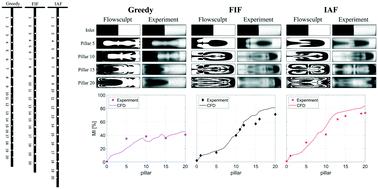Our official English website, www.x-mol.net, welcomes your
feedback! (Note: you will need to create a separate account there.)
Optimized design of obstacle sequences for microfluidic mixing in an inertial regime
Lab on a Chip ( IF 6.1 ) Pub Date : 2021-08-17 , DOI: 10.1039/d1lc00483b Matteo Antognoli 1 , Daniel Stoecklein 2 , Chiara Galletti 1 , Elisabetta Brunazzi 1 , Dino Di Carlo 3
Lab on a Chip ( IF 6.1 ) Pub Date : 2021-08-17 , DOI: 10.1039/d1lc00483b Matteo Antognoli 1 , Daniel Stoecklein 2 , Chiara Galletti 1 , Elisabetta Brunazzi 1 , Dino Di Carlo 3
Affiliation

|
Mixing is a basic but challenging step to achieve in high throughput microfluidic applications such as organic synthesis or production of particles. A common approach to improve micromixer performance is to devise a single component that enhances mixing through optimal convection, and then sequence multiple such units back-to-back to enhance overall mixing at the end of the sequence. However, the mixing units are often optimized only for the initial non-mixed fluid composition, which is no longer the input condition for each subsequent unit. Thus, there is no guarantee that simply repeating a single mixing unit will achieve optimally mixed fluid flow at the end of the sequence. In this work, we analyzed sequences of 20 cylindrical obstacles, or pillars, to optimize the mixing in the inertial regime (where mixing is more difficult due to higher Péclet number) by managing their interdependent convection operations on the composition of the fluid. Exploiting a software for microfluidic design optimization called FlowSculpt, we predicted and optimized the interfacial stretching of two co-flowing fluids, neglecting diffusive effects. We were able to quickly design three different optimal pillar sequences through a space of 3220 possible combinations of pillars. As proof of concept, we tested the new passive mixer designs using confocal microscopy and full 3D CFD simulations for high Péclet numbers (Pe ≈ O(105–6)), observing fluid flow shape and mixing index at several cross-sections, reaching mixing efficiencies around 80%. Furthermore, we investigated the effect of the inter-pillar spacing on the most optimal design, quantifying the tradeoff between mixing performance and hydraulic resistance. These micromixer designs and the framework for the design in inertial regimes can be used for various applications, such as lipid nanoparticle fabrication which has been of great importance in vaccine scale up during the pandemic.
中文翻译:

惯性状态下微流体混合障碍序列的优化设计
混合是实现高通量微流体应用(例如有机合成或粒子生产)的基本但具有挑战性的步骤。提高微混合器性能的一种常见方法是设计一种单一组件,通过最佳对流增强混合,然后将多个此类单元背靠背排序,以在序列结束时增强整体混合。然而,混合单元通常只针对初始的非混合流体成分进行优化,这不再是每个后续单元的输入条件。因此,不能保证简单地重复单个混合单元将在序列结束时实现最佳混合流体流动。在这项工作中,我们分析了 20 个圆柱形障碍物或柱子的序列,通过管理它们对流体成分的相互依赖的对流操作来优化惯性区域中的混合(由于较高的 Péclet 数,混合更加困难)。利用名为 FlowSculpt 的微流体设计优化软件,我们预测并优化了两种共流流体的界面拉伸,忽略了扩散效应。我们能够通过 32 个空间快速设计三个不同的最佳支柱序列20 种可能的支柱组合。作为概念证明,我们使用共聚焦显微镜和全 3D CFD 模拟测试了新的被动混合器设计,以获得高 Péclet 数(Pe ≈ O (10 5–6 )),观察多个横截面的流体流动形状和混合指数,达到混合效率约为 80%。此外,我们研究了柱间间距对最佳设计的影响,量化了混合性能和液压阻力之间的权衡。这些微混合器设计和惯性机制中的设计框架可用于各种应用,例如脂质纳米颗粒的制造,这在大流行期间对疫苗的放大非常重要。
更新日期:2021-08-24
中文翻译:

惯性状态下微流体混合障碍序列的优化设计
混合是实现高通量微流体应用(例如有机合成或粒子生产)的基本但具有挑战性的步骤。提高微混合器性能的一种常见方法是设计一种单一组件,通过最佳对流增强混合,然后将多个此类单元背靠背排序,以在序列结束时增强整体混合。然而,混合单元通常只针对初始的非混合流体成分进行优化,这不再是每个后续单元的输入条件。因此,不能保证简单地重复单个混合单元将在序列结束时实现最佳混合流体流动。在这项工作中,我们分析了 20 个圆柱形障碍物或柱子的序列,通过管理它们对流体成分的相互依赖的对流操作来优化惯性区域中的混合(由于较高的 Péclet 数,混合更加困难)。利用名为 FlowSculpt 的微流体设计优化软件,我们预测并优化了两种共流流体的界面拉伸,忽略了扩散效应。我们能够通过 32 个空间快速设计三个不同的最佳支柱序列20 种可能的支柱组合。作为概念证明,我们使用共聚焦显微镜和全 3D CFD 模拟测试了新的被动混合器设计,以获得高 Péclet 数(Pe ≈ O (10 5–6 )),观察多个横截面的流体流动形状和混合指数,达到混合效率约为 80%。此外,我们研究了柱间间距对最佳设计的影响,量化了混合性能和液压阻力之间的权衡。这些微混合器设计和惯性机制中的设计框架可用于各种应用,例如脂质纳米颗粒的制造,这在大流行期间对疫苗的放大非常重要。











































 京公网安备 11010802027423号
京公网安备 11010802027423号